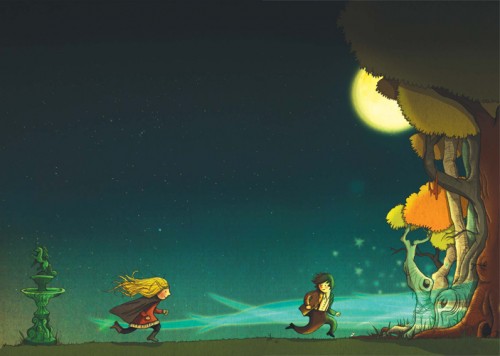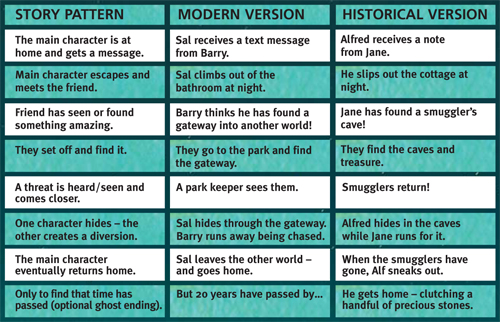Pie Corbett delves into the past to fire children's imaginations with a tale of mystery...
Heart thumping, Hetty ran upstairs. Her mother had let her wear the coronet – just for a minute – the bride’s coronet perched on her head, glinting in the firelight.
Hetty dashed into her bedroom, closed the door and wedged a chair under the door handle so that no one else could enter. She scrambled onto the wooden chest that sat below the window and scanned each diamond pane. She was looking for a message. A message from John. John Purcell.
Although Hetty wasn’t allowed to play with John, the game-keeper’s son, they had been secret friends for as long as she could remember. Wild John, with his tales of stars that fell from the sky; John who collected heron’s sea-green eggs and knew where the glow worms were to be found; John with his stories of mermen wrestled from the River Severn; John who kept a blackbird as a pet.
There it was, a message scrawled onto a tiny diamond pane of glass – Midnight Courtyard. Carefully, Hetty placed the coronet onto her sidetable, scrabbled into bed and waited. The coronet glittered in the moonlight. To stop herself from falling asleep, Hetty counted the panes of glass on the great window.Through it, she could see the blurred shape of the moon…
When the midnight bell struck, Hetty slipped from her bed. Tugging her great, dark cloak to her, she crept down the corridor. As she made her way down the wooden stairs, the eyes of her ancestors seemed to follow her – their portraits like dead dark shadows, hugging the walls. Hetty dodged several steps, knowing which ones would creak. Like a fleeting shadow, she padded towards the courtyard door, feeling the cold flagstones, cool against her bare feet.
Outside, the courtyard was bathed in moonlight. Hetty pulled the cloak to her and tiptoed across. “John,” she hissed and a shadow
whispered back.
“I seen it, a unicorn, a wee one it was…” The words tumbled out like sand running through fingers, in a jumble of excitement. Hetty followed him across the lawn, past the pond here the golden carp drifted like watery angels, down to the wood’s edge where it was dark and shadowy.

She had to run to keep up with John. Deeper and deeper they ran into the wood, till they came to a clearing, silvery with light. It looked as if the moon itself was trapped amongst the trees. John stood silent and stared. Grabbing Hetty’s arm, he held her back. For there in the clearing was a tiny unicorn, shimmering with light. Hetty gasped.
“I told you,” whispered John. But at that moment, Hetty heard a noise. Something or somebody was making their way through the wood. Then she heard a voice shouting. It was John’s father – the keeper – coming through the wood, no doubt with his sword and gun…
“Your cloak,” whispered John. And so it was that Hetty crouched down beside the tiny unicorn and pulled the cloak over them both. To anyone moving through the darkness, they looked just like a dark boulder, a vague shape in the night. Under the cloak, it was brighter than daylight. Hetty squeezed her eyes tight shut and waited, her hand stroking the unicorn’s mane. It snuffled against her.
Meanwhile, John made his way off through the forest, crashing into bushes, stamping on branches and making as much noise as he could, ever onwards, drawing his father away from Hetty’s hiding place.
When it was silent, when all that Hetty could hear was her own heartbeat and the steady breathing of the unicorn, she crept out from under the cloak. The unicorn shook its mane, pawed the ground and trotted off into the darkness. Hetty stood transfixed, watching the light flicker amongst the trees until it was gone and she was left with only the silence of the woods and herself.
Now the minutes they ran by like rabbits and the rabbits ran by like years. Hetty came back the next morning. She made her way across the dew-drenched lawn and tapped on the window pane.
Gasping, hand to her throat, her mother let her in. Hetty was bursting to tell her story of the unicorn that glowed like the moon itself… but all that her mother saw was the daughter that had disappeared one night, five years before. The same night that John Purcell had gone missing. Here she was again, wrapped in a threadbare cloak, clutching a spiralshaped bone, whiter than chalk. It was Hetty, back from wherever, with her head full of wild dreams. Dreams of unicorns, unicorns, unicorns.
© Pie Corbett.
I wrote this story on a school trip to Hellens Manor in Herefordshire. The manor is reputed to be one of the oldest buildings in the country and was probably originally constructed around the time of the Battle of Hastings in the 11th century.
On the trip, I noticed that one room was called ‘Hetty Walwyn’s Room’. During the 18th century a girl called Hetty had been confined by her mother for over 30 years after she had run away with a stable hand. On a window pane there was a message scratched with a diamond ring. Of course, rumour has it that her ghost still haunts the room. I used some of the details from the actual house, paintings and artefacts to create my historical background as well as using my imagination.
Loiter with the story for at least two or three days, if not longer. This will help the less confident internalise the patterns. Make sure that they have heard the story being read and read it themselves as often as possible. Display it on the interactive whiteboard so that it can be seen by everyone. Deepen understanding with the following activities:
• Hot-seat Hetty and her mother.
• Role-play the conversation between Hetty and John when they next meet.
• Role-play a conversation between Hetty’s mum and John’s dad when the children have gone missing – and on their return.
• Discuss what might happen on John’s return.
• Write a diary entry for Hetty and one for John.
• Draw a unicorn and label it.
• Write a description of a unicorn, using a downloaded image.
• Contrast the opening and ending – discuss the coronet and the spiral-shaped bone.
• How does the writer contrast the two characters?
• Look for techniques that the writer uses to build the suspense.
• Look for all the clues that the writer has used to set the story in the past.
• Further information about Hellens is on wikipedia or the Hellens website: http://www.hellensmanor.com
Work out with the children the underlying story pattern. In essence, the story is about two characters who leave a cosy setting and go somewhere more dangerous to find/see something precious. They are about to be discovered but one hides and the other provides a diversion. The main character manages to get back to the original setting.
Of course, in my story I have used the idea of time passing at the end – which is an echo of what happens in the Narnia stories where years can pass by in Narnia but on return the children find that only a few seconds of our time has passed. Put the underlying pattern onto a grid, e.g.
Get a whiteboard-friendly version of Pie’s story…
If you would like to share this story with your class on the whiteboard, you can download a copy from the following website http://www.teachprimary.com/download/pie-corbett

• If you want the story to be ‘historical’ this obviously works best if you can set the tale as I did, using a class trip to a castle or old manor. Somewhere like the smuggler’s caves in Hastings would be a great place for two children to hide in and nearly be caught!
• On the trip ask the children to collect a few details – about the main setting, people who lived there as well as a few artefacts. Specific names and details make a setting seem real.
• Use a digital camera to take photos of a key room or part of the building that can be shown on the whiteboard.
• Build up two contrasting characters.
• Use shared writing to gradually build up a class story while the children develop their own.
• Draw a story map to show the sequence of events.
• Use drama to role-play different parts of the story.
Behaviour management: choosing the right words
Behaviour Management
Reorganise your music room
Ace-Music
Easy ways to combat teacher stress
Ace-Heads
